![]()
![]()
![]()
Use LEFT and RIGHT arrow keys to navigate between flashcards;
Use UP and DOWN arrow keys to flip the card;
H to show hint;
A reads text to speech;
60 Cards in this Set
- Front
- Back
|
Daguerrotype
|
Daguerreotype: A camera that contains a silver coated copper plate that is light senstivite. Has a five minute exposure time. Takes a reverse image, doesn’t have negatives so you can’t reproduce the image. Usually used for still lives, not portraits.
|
|
|
Calotype
|
Calotype: Created by Henry Talbot, a camera that contained a chemically treated paper. Created negatives that could be reproduced
|
|
|
Camera Obscura
|
Camera obscura: used during the Renaissance, literally translates to “dark room”, a room that projects an image upside down so you can trace it
|
|
|
Louis-Jacques-Mande Daguerre
|
Louis-Jacques-Mandé Daguerre: Created the Daguerreotype camera, still life photographer, presented findings to the Academy of Art and Academy of Science.
|
|
|
carte-de-viste
|
carte-de-visite: Portrait photos taken at a portrait factory. Created mass production and mass audiences. Portraits created visiting cards, small photos, there were 8 shots in one camera. Not close up or retouched. Subjects used props to create different scenarios.
|
|
|
realism
|
Realism: representing the subject matter realistically, avoiding artistic convictions, implausible, and supernatural elements.
|
|
|
Gustave Courbet
|
Gustave Courbet: French painter who led the 19th century realism movement.
|
|
|
Idealism
|
Idealism: an attempt to represent the world how it should be, not how it actually is. Realizes the concept of beauty and perfection
|
|
|
Chronophotography
|
Chronophotography: a 19th century form of photography, captures movement in several frames, Precursor to cinematography.
|
|
|
en plein air
|
painting en plein air: French expression that mean painting in open air, which is the act of painting outdoors, became important to the impressionist movement.
|
|
|
Impressionism
|
Impressionism: art meant to capture a fleeting moment in time. Shaped by light and color, not form and line. Painters attempted to show what photography could not. Usually painted outside, not from a studio.
|
|
|
Haussmannization
|
Haussmannization of Paris: refers to the modernization of Paris, the city was laid out with roads, featured shops, restaurants, galleries. It was the creation of a modern city which people could walk around and spend time visiting. People began to all shop at the same stores which made class divisions less distinguished.
|
|
|
Salon des Refuses
|
Salon des Refusés: Showed artist break from the Academy and official judgement of art. Literally means “exhibition of the rejects” showed all the works that the Academy denied. Based on the idea that the public should judge the artwork. Popularized in 1863, when the academy rejected over 3,000 works.
|
|
|
complementary colors
|
Salon des Refusés: Showed artist break from the Academy and official judgement of art. Literally means “exhibition of the rejects” showed all the works that the Academy denied. Based on the idea that the public should judge the artwork. Popularized in 1863, when the academy rejected over 3,000 works.
|
|
|
Japonisme
|
Japonisme: a French term referring to art with a Japanese influence. Became a source of inspiration for many impressionist painters. Lack of perspective and shadow, usually showed flat bright colors. Not orientalism-showed western scenes in an eastern style.
impasto |
|
|
Vincent Van Gough
|
Vincent van Gogh: Dutch post-impressionist artist. Focused on rough beauty, emotional honesty, and bold colors.
|
|
|
Gauguin
|
Gauguin: First artist to gain success for Primitivism, which showed exaggerated proportions, geometric designs, and stark contrasts. Post impressionist with design oriented pieces. Spent 9 months painting with Van Gough, both were inspired by impressionism but had severe depression and a rocky relationship. Gauguin was disillusioned by impressionism and argued this with Van Gough, they frequently painted similar subjects as well as each other.
|
|
|
Cezanne
|
Cezanne: French post-impressionist. Laid the foundations of the transition from 19th to 20th century art. Considered by both Matisse and Picasso to be the father of 20th century artists. Used repetitive brush strokes and planes of color for build complex forms.
|
|
|
Fauvism
|
the style of Les Fauves (French for “wild beasts”) a group of early 20th century modern artists who emphasized painterly qualities and strong color over representational or realistic ideals maintained by impressionist. Painted traditional subject matters in wild colors. Led my Matisse and Derain.
|
|
|
The Blue Rider
|
The Blue Rider: A group of artists from Munich Germany, the group was fundamental to the expressionist movement. Featured around the works of Kandinsky and Franz Marc. Centered around the desire to express spiritual truths though their work. Believed in the promotion of modern art, the connection of visual art and music, the symbolism of color, and a spontaneous approach to painting.Pure abstraction with no recognizable subject but it had meaning.
|
|
|
Analytic Cubism
|
Analytic Cubism: The first phase of cubism, developed by Picasso and Braque. Artists pick a certain shape or shapes to depict an object as a whole. No division between object and space. No renaissance perspective. Simultaneity and 4th dimension. Objects analyzed, dissected, and resynthesized. Restricted colors
|
|
|
Synthetic Cubism
|
Synthetic Cubism: Grew from analytic cubism, used real objects in addition to painted ones. A collage on canvas. Using sheets of music or playing cards. A mix of real and painted.
|
|
|
Modernism
|
Modernism: Rejects the ideology of realism, born out of industrialization, city growth, and WWI. Makes use of the past through reprise, incorporation, and parody. Rejects enlightenment thinking and the idea of a compassionate, all-powerful creator. Often features abstract art.
|
|
|
Avant-guarde
|
Avant-garde: works that are experimental or innovative.
|
|
|
Fauve
|
Fauve: Members of the Fauvism group, most notably Matisse and Derain.
|
|
|
Salon d'Automne
|
Salon d’Automne: “Autumn Salon” held annually in Paris, France. Witnessed the launch of Fauvism and Cubism
|
|
|
arbitrary/expressive color
|
arbitrary (or expressive) color: Color that has no realistic or natural relation to the object it is depicting. Usually has emotional or expressive significance.
|
|
|
German Expressionism
|
German Expressionism: a number of related creative movements in Germany after WWI
|
|
|
The Bridge
|
The Bridge: A group of german expressionist. Major impact on 20th century art and expressionism. Often compared to the Fauves, with shared interest in primitive art. Both were non-naturalistic, crude drawing, and didn’t like complete abstract. Bridge artists often painted agitated city streets or sexually charged events which made fauvism seem tame. Group defined by a manifesto.
|
|
|
Cubism
|
Cubism: avant-guarde art movement that revolutionized European art. Most influential art movement of the 20th century. Objects are analyzed then broken up into abstracted forms. Often artists represent the object from multiple viewpoints . Most notably associated with Picasso
|
|
|
Simultaneity
|
Simultaneity: depicts more than one view point of the same object on the same plane. A feature of cubist art.
|
|
|
the fourth dimension
|
the fourth dimension: the idea of time as a dimension in addition to length, width, and depth. Simultaneity is a way to depict this, shows how two kinds of perception interact together as we interact with objects.
|
|
|
papier colle
|
papier collé: a painting technique and type of collage. Artists paste flat pieces of paper onto canvas like collage except the painted pieces are objects themselves
|
|
|
collage
|
Collage: art made from assembling different forms to create a new one.
Assemblage: Artistic process of making art with found objects. |
|
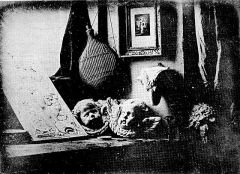
|
The Artist's Studio- Dagueree, France, Early Photography
Example of a photo taken with the daguerrotype camera. You needed a five minute exposure for the camera to work so the subjects were often still lives. You would get a reverse image and no negative so you could only make one copy of the photo. |
|
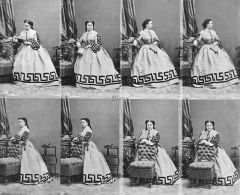
|
Portrait of an Unidentified Woman- Disderi, France, Early Photography
Taken with a Callodion camera that created negatives, sparked commercialized photography. Photographers set up Photography Factories where they could have assistants and a 48 hour service. Created Carte-de-Visit, which were calling cards that could take 8 shots in one camera. |
|
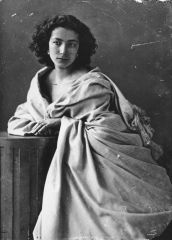
|
Portrait of Sarah Bernhard- Nadar, France, Early Photography.
Wanted photography to be recognized as an art, not commercialization. Wanted portraits to show the individual. Used outward appearances to describe a person. |
|
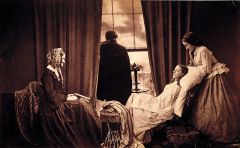
|
Fading Away- Peach Robinson, England, Early Photography
Peach Robinson staged his photos, thought of them as paintings and he was creating a scene. Often sketched out his photos before taking them. In this photo he shows a dying girl and the people caring for her, with the doctor looking out the windows. It was supposed to spark emotions and initiate discussions but people were angered that the girl was healthy in real life. They felt their trust had been violated and as if it wasn't authentic. |
|
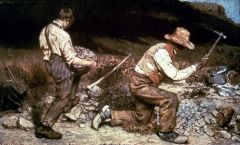
|
The Stone Breakers- Courbet, France, Realism
A painting that isn't historical or romantic but completely based in reality. Not meant to be an allegory but show realistic life. |
|
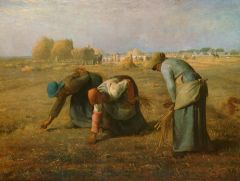
|
The Gleaners- Millet, France, Realism
About understand self and profession, shows hardworking women but you can't see their faces. Idealistic landscape juxtaposed with hardwork. Represents the women in a dignified way. |
|
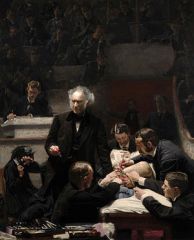
|
The Gross Clinic- Eakins, US, Realism
Painting shows a real life surgery, uses light on the body and, professor, and surgeon's forehead to illustrate knowledge. |
|
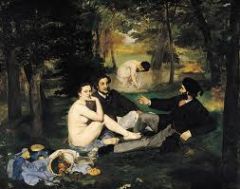
|
Luncheon in the Grass- Manet, France, Impressionism
Still has some realistic qualities but not in subject. It makes a statement of artistic freedom by featuring nude females juxtaposed with completely dressed men. There is a lack of depth in the background and almost a studio quality to it. It is inconsistent and unnatural.The painting broke a lot of academy standards like using a large format not for a history painting, distinctive brush strokes, and an appearance of being unfinished at parts. |
|
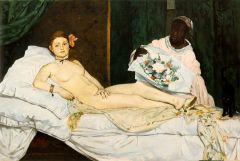
|
Olympia- Manet, France, Impressionism
Based on Titan's Venus of Urbino but made her out to be a prostitute (elements such as the orchid, her confrontational gaze, the black ribbon, the cat all show this.) She is asserting her independence and dominance. Uses quick brushstrokes, studio lighting to eliminate midtones. Large color surfaces and shallow depths. It isn't an idealistic nude but instead is brave and harsh. |
|
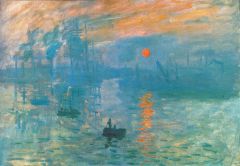
|
Impression:Sunrise- Monet, France, Impressionism
-gave the name to impressionism, which means it is an impression of a fleeting moment in time. -very loose brush strokes, landscapes are a frequent subject of time -uses light to capture an instantaneous moment, often a fleeting one such as a sunrise |
|
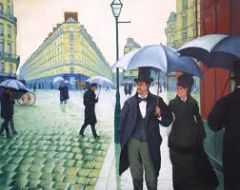
|
Paris Street, Rainy Day- Caillebotte, France, Impressionism
He was heavily influenced by photography because he liked how it captures a moment. Plays with different focuses, foreground is slightly out of focus, midground is focused, and background looses focus. He crops characters to show them coming in and out of the photo, not a carefully composed composition. Snapshot of a daily life |
|
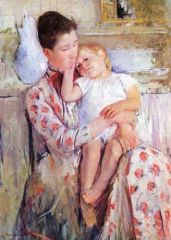
|
Mother and Child- Cassatt, France, Impressionism
Cassatt was snubbed by the Academy so she joined the impressionist movement. She liked to paint real people and often focused on the family relationship (most specifically females because that is what she knew). She liked bright colors and loose brush strokes |
|
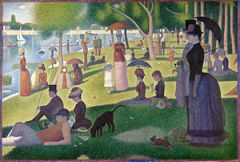
|
The Island of La Grande Jatte- Seurat, France, Post-Impressionism
Seurat spent over two years studying the landscape, he reworked it in many drawings. Not the spontenaity of impressionist paintings but wanted to show the symbolic content not the actual moment. Methodically studied the colors, combined dots of different hues to create the single hue in the viewers eyes. |
|
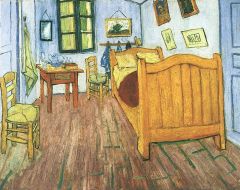
|
Bedroom in Arles- Van Gogh, France, Post Impressionism
This is a painting of his own bedroom, he didnt worry about shading or shadows but focused on areas of color. Wanted to show the feeling, not actual perspectives. |
|
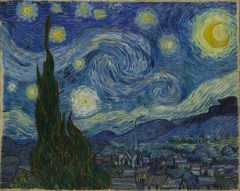
|
Starry Night- Van Gogh, France, Post Impressionism
Features a night sky over a town with dramatic and dominating stars and a huge cypress tree. It emphasizes the works of nature over that which is manmade. He was recording his emotional state over the actual appearance. This was painted from his room at an asylum. It was symbolic of life and death. |
|
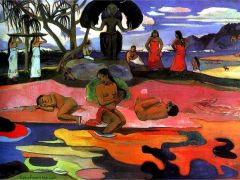
|
Mahana no atua (Day of the God)- Gaugin, France, Post Impressionism
The painting features a fictionalized account of his trip to Tahiti, it is painted from imagination not rel life. He used antinaturalistic colors and combined what he saw with what he felt. DIvided into three horizontal levels of increasing abstraction with the upper level being realistic and the bottom level being abstract. The people in the middle are rising and in the fetus position, possibly representational of life and death. The bottom is puzzle like and doesn't have any reflections of the real world. He is trying to show the mysteriousness of thought. |
|

|
Mont Sainte-Victoire- Cezanne, France, Post-Impressionism
Cezanne painted multiple pictures of this mountain, each becoming increasingly less realistic. He used geometry as a way to describe nature, breaking things up into different shapes and using color to represent the depth of objects. |
|
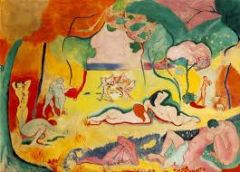
|
Joy of Life- Matisse, France, Fauvism
Features a landscape with brilliantly colored forests meadows seas and sky. Nude figures are both at rest and in motion. Color is used as an emotional expression and the landscape functions as a stage to the figures. The sensual figures show pure pleasure. He doesn't concern himself with scales and proportions. |
|
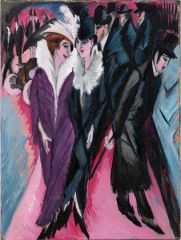
|
Street, Berlin- Kirchner, Germany, Expressionism (The Bridge)
This painting is a rebellion against the principles of academic painting. He tried to portray the gritty energy of the city through perspectives, jagged brush strokes, angular forms, and sharp colors. The painting features prostitutes with plumed hats. |
|
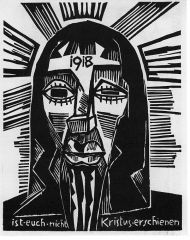
|
Christ- Schmidt-Rottluff, Germany, Expressionism (The Bridge)
The Bridge liked to create primitive art with jagged angles and crude drawings. The revived the use of woodcut prints, as seen here. |
|
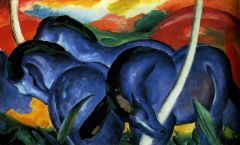
|
The Large Blue Horses- Marc, Germany, Expressionism (The Blue Rider)
Three blue horses in front of a red hill landscape. Primary and nonnaturalist colors. Features simplicity and a strong sense of emotion. The lines of the horses are mimicked in the landscape uniting them in a harmonious way, the curved lines represent harmony, peace, and balance. There was an emotional and psychological meaning to his use of colors: blue is masculinity and spirituality, yellow is feminine joy, and red encases the sound of violence. Its an attempt to evoke and spiritual and transcendental feeling from the viewer. Marc thought animals were more pure and beautiful then man and had a better understanding of the divine. Wanted to evoke the essence of the animal and thought the feeling was more important than the subject matter. |
|

|
Improvisational #28- Kandinsky, Germany, Expressionism (The Blue Rider)
Kandinsky's work often featured the image of a blue horseback rider. As his work progressed it became more and more abstracted. The rider became symbolic of the Horseman of the Apocalypse who would bring destruction and ultimately redemption to the world. Improvisational #28 is a picture of boats and waves, a serpent, and maybe cannons on the left show the destruction, while the embracing couple and sunshine show the ultimate redemption on the right. While almost completely abstracted, it is still a landscape painting. |
|
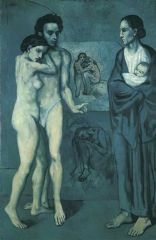
|
La Vie- Picasso, France, Blue Period
Picasso paints this entirely in blue for psychological reasons, it represents his melancholia and mental depression at the time. This is possibly the theme of the cycle of life as he represents different people at different stages in life, but he leaves the interpretation up to the viewer. He shows the different realities of people as he paints them in different styles. |
|
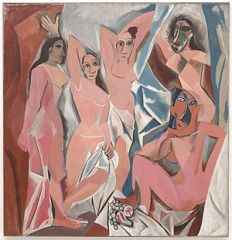
|
Les Demoiselles d'Avignon, France, Proto-Cubism
This painting started as a narrative structure of a man surrounded by dancing women, he developed it into the beginnings of cubism by abstracting the figures until they started to change or disappear entirely. He followed the guidelines of primitive art, where he could paint in any size and proportion he likes. He developed the idea of a 4th dimension, where the same figure could be seen from multiple dimensions at one time. The new theme is the idea of a fetish painting with men as women and people in African masks. |
|
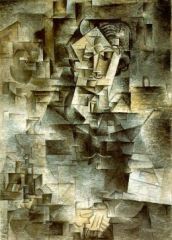
|
Portrait of Henry-Daniel Kahnweiler- Picasso, France, Analytic Cubism
He uses very strict lines and shapes. Breaks down the subject into its basic shapes then builds them back together. He gets an almost completely abstracted image but you are still able to make out the portrait within. Through this Picasso wished to not imitate but create form. |
|
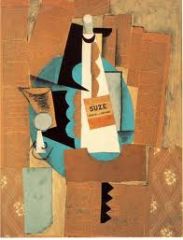
|
Glass and Bottle of Suze- Picasso, France, Synthetic Cubism
Picasso built this out of pieces of newspaper clippings that discussed the conflict in the Balkins leading up to WWI. Synthetic cubism is using actual papers and painting to create an image. He consciously chose certain articles and papers to create his subject matter. This is the beginning of collage. |

